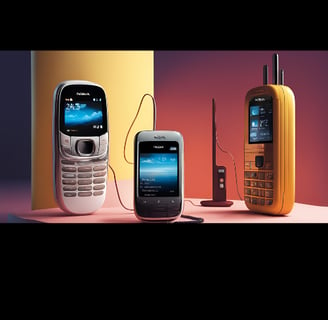The Rise and Fall of Nokia: A Lesson in Adaptability
Nokia was once the undisputed king of mobile phones. In the early 2000s, almost everyone either owned or wanted a Nokia phone. They were known for their durability, long battery life, and iconic models like the Nokia 3310 and N95. But despite its massive success, Nokia’s reign didn’t last. Within a decade, the company that once controlled over 40% of the global mobile market had faded into the background. So, what went wrong? More importantly, what can businesses learn from Nokia’s story?
Gaurav Takle
2/10/20252 min read


The Rise: Innovation and Market Domination
Nokia’s journey started in Finland in the 19th century, but it wasn’t until the 1980s and 90s that it became a tech powerhouse. With the rise of mobile phones, Nokia focused on making user-friendly, reliable, and affordable devices. They introduced features like SMS, color screens, and early mobile internet, keeping them ahead of competitors.
By the early 2000s, Nokia was leading the mobile revolution, launching bestsellers like the Nokia 1100 and Nokia 6600. Their operating system, Symbian, became the most used mobile OS worldwide.
The Fall: Resistance to Change
Despite its dominance, Nokia made a critical mistake—it failed to adapt.
Ignoring the Smartphone Revolution – While Apple launched the iPhone in 2007 and Google introduced Android in 2008, Nokia stuck to its Symbian OS, which was outdated and difficult to upgrade.
Slow Decision-Making – Nokia had the resources to compete with Apple and Google but lacked the agility. Internal conflicts and bureaucratic delays prevented necessary innovations.
Underestimating Competitors – Nokia didn’t take Android seriously, believing its brand loyalty would be enough to sustain its market share. But soon, Samsung and other Android brands took over.
By the time Nokia finally switched to Windows OS in 2011, it was too late. Consumers had already embraced iPhones and Android devices.
The Lesson: Adapt or Get Left Behind
Nokia’s fall is a powerful reminder that success is never guaranteed. No matter how big or established a company is, failure to adapt, innovate, and respond to market trends can lead to downfall.
Here’s what businesses can learn from Nokia:
✅ Stay ahead of trends – Don’t ignore market shifts; be prepared for disruption.
✅ Listen to customers – If users want a better experience, don’t resist change.
✅ Embrace new technology – Innovation should always be a priority.
✅ Make bold decisions – Companies need to take risks to stay relevant.
Where is Nokia Today?
After selling its mobile division to Microsoft in 2014, Nokia focused on network infrastructure and 5G technology. It has made a slow comeback but is no longer a dominant player in the mobile phone market.
However, its story remains a case study in why adaptability is key to long-term success.
Would Nokia have survived if it had embraced Android early on? Possibly. But one thing is certain—businesses that resist change will eventually be replaced by those who don’t.
